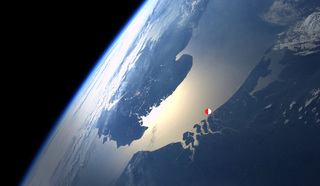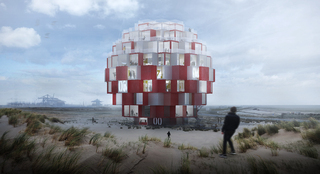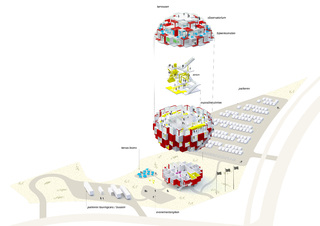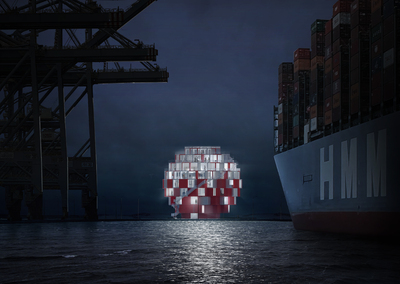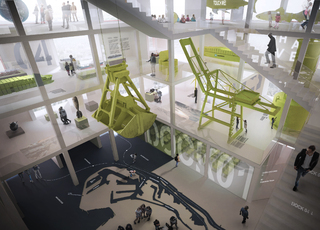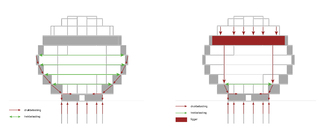
Port of Rotterdam Experience Centre
Maasvlakte 2
junction
The port of Rotterdam is an enormous logistics hub between the seas of the world and the major rivers of Western Europe. The port is the largest in Europe, and a large part of the goods consumed there is imported via Rotterdam and transported further by water, road or rail. A large part of the export from Europe also runs via the port of Rotterdam.
The newest and most modern part of the port is Maasvlakte 2, a beautiful example of typical Dutch land reclamation. This spit of land, which juts deep into the North Sea, has space for large-scale container terminals, among other things. The Maasvlakte is so large that it is clearly visible from space as an abutment that reaches out to other parts of the world.
The newest and most modern part of the port is Maasvlakte 2, a beautiful example of typical Dutch land reclamation. This spit of land, which juts deep into the North Sea, has space for large-scale container terminals, among other things. The Maasvlakte is so large that it is clearly visible from space as an abutment that reaches out to other parts of the world.
the Port of Rotterdam: a giant logistics hub between the world's oceans and major rivers of Europe
attraction
In the port of Rotterdam, the impression and atmosphere are determined by a spectacle of enormous machines, fast logistics processes and unpolished shapes. It therefore has its own aesthetic that is very attractive to many.
The business community, social organizations as well as day trippers and tourists are curious about the activity, processes and aesthetics of the largest industrial area in the Netherlands.
To meet the great interest in the port, the Port Authority wants to build a new Port Experience Center (HEC). A location has been selected for this purpose on the extreme western edge of Maasvlakte 2, a location that offers a view of the sea on the one hand, and a spectacular view of the port on the Maasvlakte on the other. The route to this location leads through the impressive harbor landscape of Rotterdam, making the journey part of the experience at the HEC.
The aim of this Port Experience Center is that it “contributes to the image of port (activities) (...) to relevant target groups and stakeholders. The center provides insight into goals and dilemmas that play a role in today's port, which is preparing for the future. ”
The business community, social organizations as well as day trippers and tourists are curious about the activity, processes and aesthetics of the largest industrial area in the Netherlands.
To meet the great interest in the port, the Port Authority wants to build a new Port Experience Center (HEC). A location has been selected for this purpose on the extreme western edge of Maasvlakte 2, a location that offers a view of the sea on the one hand, and a spectacular view of the port on the Maasvlakte on the other. The route to this location leads through the impressive harbor landscape of Rotterdam, making the journey part of the experience at the HEC.
The aim of this Port Experience Center is that it “contributes to the image of port (activities) (...) to relevant target groups and stakeholders. The center provides insight into goals and dilemmas that play a role in today's port, which is preparing for the future. ”
the atmosphere is determined by efficiency, raw shapes and enormous machines
architectural concept
The nautical world has a rich amount of references of functional beacons that at the same time form powerful architecture. The major and minor beacons along the coast and waterways used for the navigation of ships are clearly visible thanks to their color, height and lighting. In many cases, these objects also mark special locations on the border between land and water and give this extra identity. Not infrequently, lighthouses in particular are therefore even a tourist destination. They not only act as a functional beacon for orientation, but often lead to contemplation and inspiration as they communicate with an unprecedented world beyond the horizon. We want to realize a modern beacon that refers to these powerful nautical beacons, and at the same time also fits in with the function of a visitor center with a voluminous program. All-round orientation, an express wish of the Port Authority, is the starting point in this respect. That is why we have chosen a sphere (globe) as the main shape. A powerful, poetic and iconic head shape with all-round orientation. The shape can also be associated with a globe, symbolizing the worldwide network to which the port of Rotterdam is connected. It thus gives an architectural expression to the global character of this place; you are in a world port! In a sense, the sphere is also utilitarian and can also be found here and there in the port as a storage facility. It combines a maximum volume with a limited facade surface and distributes the pressure evenly.
At this location, a free-standing spherical building will appeal to the imagination. It is immediately clear that there is something special here and it will appeal to passers-by. It marks its function as a visitor center and can act as an icon for the port. By making the building sufficiently high and providing it with red signal colors, the building becomes clearly visible from the distant surroundings. Seen from the sea, the HEC lights up like an object on the horizon, and when viewed from the harbor, its colors shimmer in the jungle of cranes and ships, to show visitors the way to the building. However, the HEC is not only a beacon, but also a functional building with architectural logic. The logistics processes of the container terminals in the immediate vicinity offer starting points for this. Containers can be easily transported and stacked quickly, and are therefore comparable to an ideal modular construction system. A building consisting of such modular elements can be constructed quickly and cheaply. And in the future, it may also be relatively easy to adapt or dismantle and reuse. Just like the stacks of containers in the area, the HEC is made up of modular elements. This allows it to be built in a practical way. The modules could be made off site (in a factory), possibly even including interior and exhibition elements. Architecturally that also makes it extra exciting. This ensures that the building is experienced differently from different distances. From afar, the angular details of the building are less visible, dominating the image of the sphere. Closer up, the sphere remains the main shape, but the elements in which the red and white colors are applied are clearly visible, and it creates the association with the beacons in the port area. The sturdy, angular shapes of the building are visible from the immediate vicinity, which match the formal language in the area. Another important result of the modular construction is that beautiful terraces with a view of the top layers are created.
location
The building of the Harbor Experience Center will be placed centrally on the intended plot in the beautiful dune landscape. The building is high enough to have a good view over the dunes. Parking for visitors is planned on the north side of the building, and on the south side the parking space for buses for excursions and transfers to the tour boat in the Ameliahaven. It is also possible to realize an additional walking connection to the Ameliahaven. Cars and buses have separate entrances so that the excursion buses do not suffer from any congestion. The amount of hardening remains as limited as possible. It will be investigated whether semi-paving is a possibility, so that the site looks as natural as possible at less busy times. In the armpit of the road, clearly visible to passers-by, is the events square where special activities can take place. Adjacent to this site is the sunny terrace of the "Antarctica" bistro, which is placed at the bottom of the building. The dunes provide shelter from the wind. Visitors can extend their stay at the HEC here. Passers-by are also welcome here who do not need to visit the HEC.
allocation of functions
On the ground floor, next to the bistro, there is also an inviting staircase (and elevator) to the 1st floor, where the reception area of the HEC is located. Here visitors are welcomed, provided with information and can buy (possible) tickets for the exhibition and / or excursions. Here you will also find a shop, the offices, the toilet facilities and the cloakroom. Visitors are then guided through a "transfer room" to the upper exhibits, which are located around an impressive atrium. Larger objects are exhibited in this atrium and the stairs and the lift have been placed, which provide theatrical access to the higher parts of the building. The atrium is the beating heart of the building, where there is constant activity. The exhibition spaces are positioned around this atrium, allowing for many visual relationships between different parts and objects. The atrium has a "sculptural" design so that the adjacent floors have different heights. This allows both intimate spaces to be created and double-height spaces where larger objects can stand. This creates a dynamic image where visitors are challenged to investigate. The atrium can also fulfill a building physics role, whereby the warm (and CO2 polluted air) rises and is extracted at the top of the atrium. Clean sea air can then be sucked in through the facades.
Anyone on their way to the HEC will see the building looming up from a distance thanks to its striking shape and colors
At the top of the building there are meeting rooms such as the conference center, the restaurant and the observatory. There are also the terraces that offer a view over the harbor and sea. These functions can be visited separately or in combination with the exhibition. We have added the observatory as a part of the program, because we want to offer visitors who mainly come for the view this opportunity, without having to visit the exhibition or the restaurant "compulsory". Visitors who only come for the meeting rooms, observatory or restaurant can take the lift directly from the reception area on the first floor. Another option is a spectacular staircase that runs outside the building. This staircase also functions as an escape route from the building. By making the terraces at the top of the building accessible (via draft gates) and by providing the building with a lot of glass, especially on the top layers, visitors can enjoy a beautiful view of the surroundings from all sides of the building. Together with the exhibition maker, it will be determined how much glass is desirable on the floors where the exhibition is located.
experience
Anyone en route to the HEC will see the building looming up in the port world from a distance thanks to its striking shape and colors. The building is visible from both the roads and the cycle paths and guides visitors in the right direction both during the day and after dark.
Visitors to the exhibition are led to the first floor via a wide staircase (or via a lift for the disabled). Here they are welcomed and can obtain a ticket. From this welcome area, visitors are guided via the "transition room" to the central square in the exhibition area and possibly to the adjacent group reception area. Here you can see the impressive atrium in which objects of spectacularly large size are exhibited. Via the stairs located in the atrium that offer a view of the objects in the atrium, visitors move up to the top layer of the exhibition area where the “future zone” is located. After this, the visitor ends up in the restaurant with lots of glass and beautiful terraces. For a full experience of the harbor, visitors can climb further up to the observatory and panoramic terrace that offers a 360 degree view of the harbor and the sea where ships of enormous size approach or depart Rotterdam for all parts of the world.
Visitors to the exhibition are led to the first floor via a wide staircase (or via a lift for the disabled). Here they are welcomed and can obtain a ticket. From this welcome area, visitors are guided via the "transition room" to the central square in the exhibition area and possibly to the adjacent group reception area. Here you can see the impressive atrium in which objects of spectacularly large size are exhibited. Via the stairs located in the atrium that offer a view of the objects in the atrium, visitors move up to the top layer of the exhibition area where the “future zone” is located. After this, the visitor ends up in the restaurant with lots of glass and beautiful terraces. For a full experience of the harbor, visitors can climb further up to the observatory and panoramic terrace that offers a 360 degree view of the harbor and the sea where ships of enormous size approach or depart Rotterdam for all parts of the world.
From this viewpoint and the restaurant, a staircase that winds around the HEC on the outside leads down, offering a constantly changing view of the surroundings. On the first floor, visitors are led back into the building from the stairs. The shop is located at that location, and from there the building can be left again or an excursion or other activity can be booked.
Visitors who come exclusively in front of the restaurant and / or the observatory are offered the option of taking the lift directly from the reception area or taking the stairs on the outside of the building. The restaurant has windows all around, and therefore offers a wide view. In good weather you can take a seat at the tables set up on the terraces around the restaurant. Afterwards (or in a different order), diners can visit the observatory to enjoy the view, and then leave the building via the outside stairs (or by elevator) and the shop.
Anyone who visits the HEC to participate in a meeting or other private gathering can choose to take the elevator directly to the meeting center via the welcome area upon arrival. The outside stairs are also a possibility for these visitors. Once there, participants are received in a reception area (lobby) with a view where the opportunity is offered for an informal meeting. We have added this function to the program. From there you can enter the meeting rooms, which all offer a view of the surroundings, but can also be darkened. Both the meeting rooms and the reception area on this floor have terraces where informal meetings can take place. Catering is provided from the restaurant located directly above.
After the meeting, participants can take the elevator down or descend the stairs on the outside to enjoy the view of the harbor and sea even more. A combination visit with the exhibition, restaurant and / or observatory is of course also possible.
The Harbor Experience Center forms a recognizable and striking beacon in the landscape not only for visitors but also for passers-by. For people who cycle past and have visited the beach or are in the vicinity of the building for other reasons, the opportunity is offered to visit the bistro located at the bottom of the building. In good weather, orders can be placed at the outside counter, after which you can take a seat on the terrace. Children can also use the playground equipment in the playground. The bistro also features seating in the building. The bistro and terrace are adjacent to the events square.
In addition to passers-by, the bistro is of course also open to visitors to the exhibition or the other functions in the HEC as an extension of their visit.
Visitors who come exclusively in front of the restaurant and / or the observatory are offered the option of taking the lift directly from the reception area or taking the stairs on the outside of the building. The restaurant has windows all around, and therefore offers a wide view. In good weather you can take a seat at the tables set up on the terraces around the restaurant. Afterwards (or in a different order), diners can visit the observatory to enjoy the view, and then leave the building via the outside stairs (or by elevator) and the shop.
Anyone who visits the HEC to participate in a meeting or other private gathering can choose to take the elevator directly to the meeting center via the welcome area upon arrival. The outside stairs are also a possibility for these visitors. Once there, participants are received in a reception area (lobby) with a view where the opportunity is offered for an informal meeting. We have added this function to the program. From there you can enter the meeting rooms, which all offer a view of the surroundings, but can also be darkened. Both the meeting rooms and the reception area on this floor have terraces where informal meetings can take place. Catering is provided from the restaurant located directly above.
After the meeting, participants can take the elevator down or descend the stairs on the outside to enjoy the view of the harbor and sea even more. A combination visit with the exhibition, restaurant and / or observatory is of course also possible.
The Harbor Experience Center forms a recognizable and striking beacon in the landscape not only for visitors but also for passers-by. For people who cycle past and have visited the beach or are in the vicinity of the building for other reasons, the opportunity is offered to visit the bistro located at the bottom of the building. In good weather, orders can be placed at the outside counter, after which you can take a seat on the terrace. Children can also use the playground equipment in the playground. The bistro also features seating in the building. The bistro and terrace are adjacent to the events square.
In addition to passers-by, the bistro is of course also open to visitors to the exhibition or the other functions in the HEC as an extension of their visit.
the new Port Experience Center offers space for meeting and the story of the port.
building physics and building installations
The starting point is that the building is also as sustainable as possible in terms of energy use. The glass fronts are therefore fitted with state-of-the-art solar heat-resistant glass, so that no (view-obstructing) sun protection is required. The closed parts of the facade are fitted with colored thin film solar panels. Recently red solar panels have also become available on the market!
Heat and cold are exchanged by means of a low-temperature floor system with the adjacent seawater or the water from the Amaliahaven. This is a tried and tested system and is used at several locations, including the Maastoren in Rotterdam.
The waste water from the building and the site is treated in a "dune filter". Wastewater is pumped high into the dunes and purified naturally by passage along the many sand.
Heat and cold are exchanged by means of a low-temperature floor system with the adjacent seawater or the water from the Amaliahaven. This is a tried and tested system and is used at several locations, including the Maastoren in Rotterdam.
The waste water from the building and the site is treated in a "dune filter". Wastewater is pumped high into the dunes and purified naturally by passage along the many sand.
facade
The new Harbor Experience Center will be built on a location on the coastline on a spit of land protruding far into the sea. Given the extreme weather conditions, the local climate type falls into the toughest category in terms of weather influences on the facade. This is especially true for the sea salt. Salt is an oxidizer and accelerates the corrosion process. Corrosion is an electrochemical reaction and occurs when a material is exposed to its environment. Corrosion leads to loss of strength, material crumbling and discoloration. In addition, the façade is additionally loaded by drifting sand. Sand that rubs against the facade due to the influence of the wind causes wear and can damage the facade.
In order to withstand the extreme climate on site, panels made of biobased plastic are chosen for the HEC. This plastic is an alternative to traditional materials made from fossil raw materials.
Biocomposite façade panels will be used for the new Harbor Experience Center. Biocomposite is an aesthetic and environmentally friendly bio / circular material. The base consists of fibers that can no longer be used elsewhere. These can be residual flows from the clothing industry, agriculture and landscape. A bioresin is used as a binder and filler instead of a petroleum-based resin. The product is corrosion resistant because it does not contain any reaction products that cause corrosion. This makes the application at the sea possible. It must be treated with a protective lacquer for the color and UV resistance. It will be investigated whether it is possible to add the dyes directly to the resin, so that the material is colored through and through and no top coat is required.
In order to withstand the extreme climate on site, panels made of biobased plastic are chosen for the HEC. This plastic is an alternative to traditional materials made from fossil raw materials.
Biocomposite façade panels will be used for the new Harbor Experience Center. Biocomposite is an aesthetic and environmentally friendly bio / circular material. The base consists of fibers that can no longer be used elsewhere. These can be residual flows from the clothing industry, agriculture and landscape. A bioresin is used as a binder and filler instead of a petroleum-based resin. The product is corrosion resistant because it does not contain any reaction products that cause corrosion. This makes the application at the sea possible. It must be treated with a protective lacquer for the color and UV resistance. It will be investigated whether it is possible to add the dyes directly to the resin, so that the material is colored through and through and no top coat is required.
timber construction
Voor de constructie van het HEC wordt gekozen voor een schijven-kolommen principe. Door schijven langs de buitengevel in het onderste deel van het gebouw te plaatsen kunnen de verticale belastingen uit de uitkragende bovengelegen verdiepingen eenvoudig worden weggeleid naar de fundering. De daarbij optredende horizontale belasting wordt weggeleid naar de verdiepingsvloeren die als trekring fungeren.
Om de bovengelegen verdiepingen te dragen worden boven het atrium verdiepingshoge liggers aangebracht. Deze liggers dienen tegelijkertijd als tussenwanden van de verschillende functies op die laag. Via kolommen die door het gebouw naar beneden lopen worden de verticale belastingen uit deze liggers weggeleid naar de fundering. De lagen daarboven worden eenvoudig gestapeld, en hebben daarom geen zware constructie nodig. Hierdoor kan de gevel van het restaurant en de panoramaruimte erboven uitgevoerd worden zonder zware constructieve delen, en daardoor zo veel mogelijk zicht bieden op de omgeving.
Het HEC wordt voorzien van een hybride constructie van hout en staal. De zwaarst belaste delen worden in staal uitgevoerd, met name in het onderste deel van het gebouw. De vloeren, wanden en kolommen (op de hogere lagen) worden zo veel mogelijk uitgevoerd in gelamineerd hout. Voor de vloeren en wanden gaat het daarbij om de toepassing van ‘kruislaags hout’ (cross laminated timber), een soort hele dikke multiplex.
Het gebruik van het hout komt tegemoet aan de ambitie om een zo duurzaam mogelijk gebouw te realiseren. Daarmee draagt het gebouw ook bij (en geeft het uitdrukking) aan de duurzaamheidsambities van het Havenbedrijf. We leren al vroeg op school dat bomen CO2 onder invloed van zonlicht omzetten in glucose, ofwel in hout. Als bomen sterven en vergaan dan komt deze CO2 weer vrij. Als we hout verbranden en gebruiken voor het opwekken van elektriciteit en het verwarmen van onze huizen dan komt de opgeslagen CO2 ook weer vrij. Echter, als we er bouwmaterialen van maken dan kunnen we de CO2 voor tientallen, misschien wel honderden jaren vastleggen! Met andere woorden: door met hout te bouwen wordt in feite CO2 onttrokken aan de atmosfeer. Kortom, door te bouwen met houten elementen wordt bijgedragen aan de vermindering van het broeikaseffect.
Juist een gebouw dat geconstrueerd wordt uit modulaire elementen leent zich goed om voor houtbouw. Deze elementen kunnen volledig geprefabriceerd worden en op locatie in korte tijd worden geassembleerd. Daarmee kan de bouwtijd aanzienlijk worden verkort. Het biedt ook flexibiliteit bij veranderende wensen in de toekomst; hout laat zich eenvoudig modificeren. Een houten gebouw is daarmee toekomstvast.
Het is belangrijk om hier te vermelden dat de houten delen zich allemaal aan de binnenzijde van het gebouw bevinden, volledig afgeschermd van de elementen. Het hout is daardoor dus ook niet onderhevig aan verwerende processen en blijft in optimale conditie. Ook is er door de toepassing van massiefhout geen verhoogd brandgevaar. Tot slot is de toepassing van massiefhout ook economisch steeds concurrerender met traditionele materialen als beton en staal.
Om de bovengelegen verdiepingen te dragen worden boven het atrium verdiepingshoge liggers aangebracht. Deze liggers dienen tegelijkertijd als tussenwanden van de verschillende functies op die laag. Via kolommen die door het gebouw naar beneden lopen worden de verticale belastingen uit deze liggers weggeleid naar de fundering. De lagen daarboven worden eenvoudig gestapeld, en hebben daarom geen zware constructie nodig. Hierdoor kan de gevel van het restaurant en de panoramaruimte erboven uitgevoerd worden zonder zware constructieve delen, en daardoor zo veel mogelijk zicht bieden op de omgeving.
Het HEC wordt voorzien van een hybride constructie van hout en staal. De zwaarst belaste delen worden in staal uitgevoerd, met name in het onderste deel van het gebouw. De vloeren, wanden en kolommen (op de hogere lagen) worden zo veel mogelijk uitgevoerd in gelamineerd hout. Voor de vloeren en wanden gaat het daarbij om de toepassing van ‘kruislaags hout’ (cross laminated timber), een soort hele dikke multiplex.
Het gebruik van het hout komt tegemoet aan de ambitie om een zo duurzaam mogelijk gebouw te realiseren. Daarmee draagt het gebouw ook bij (en geeft het uitdrukking) aan de duurzaamheidsambities van het Havenbedrijf. We leren al vroeg op school dat bomen CO2 onder invloed van zonlicht omzetten in glucose, ofwel in hout. Als bomen sterven en vergaan dan komt deze CO2 weer vrij. Als we hout verbranden en gebruiken voor het opwekken van elektriciteit en het verwarmen van onze huizen dan komt de opgeslagen CO2 ook weer vrij. Echter, als we er bouwmaterialen van maken dan kunnen we de CO2 voor tientallen, misschien wel honderden jaren vastleggen! Met andere woorden: door met hout te bouwen wordt in feite CO2 onttrokken aan de atmosfeer. Kortom, door te bouwen met houten elementen wordt bijgedragen aan de vermindering van het broeikaseffect.
Juist een gebouw dat geconstrueerd wordt uit modulaire elementen leent zich goed om voor houtbouw. Deze elementen kunnen volledig geprefabriceerd worden en op locatie in korte tijd worden geassembleerd. Daarmee kan de bouwtijd aanzienlijk worden verkort. Het biedt ook flexibiliteit bij veranderende wensen in de toekomst; hout laat zich eenvoudig modificeren. Een houten gebouw is daarmee toekomstvast.
Het is belangrijk om hier te vermelden dat de houten delen zich allemaal aan de binnenzijde van het gebouw bevinden, volledig afgeschermd van de elementen. Het hout is daardoor dus ook niet onderhevig aan verwerende processen en blijft in optimale conditie. Ook is er door de toepassing van massiefhout geen verhoogd brandgevaar. Tot slot is de toepassing van massiefhout ook economisch steeds concurrerender met traditionele materialen als beton en staal.
year
2020
team
ir. Marco Vermeulen, ir. Joyce Langezaal, Msc. M.Arch. Bertus van Woerden, BSc. Jasper Veldhuis
programme
exposition, restaurant, conference
status
tender
2020
team
ir. Marco Vermeulen, ir. Joyce Langezaal, Msc. M.Arch. Bertus van Woerden, BSc. Jasper Veldhuis
programme
exposition, restaurant, conference
status
tender
next project:
The Road to Paris
related projects

